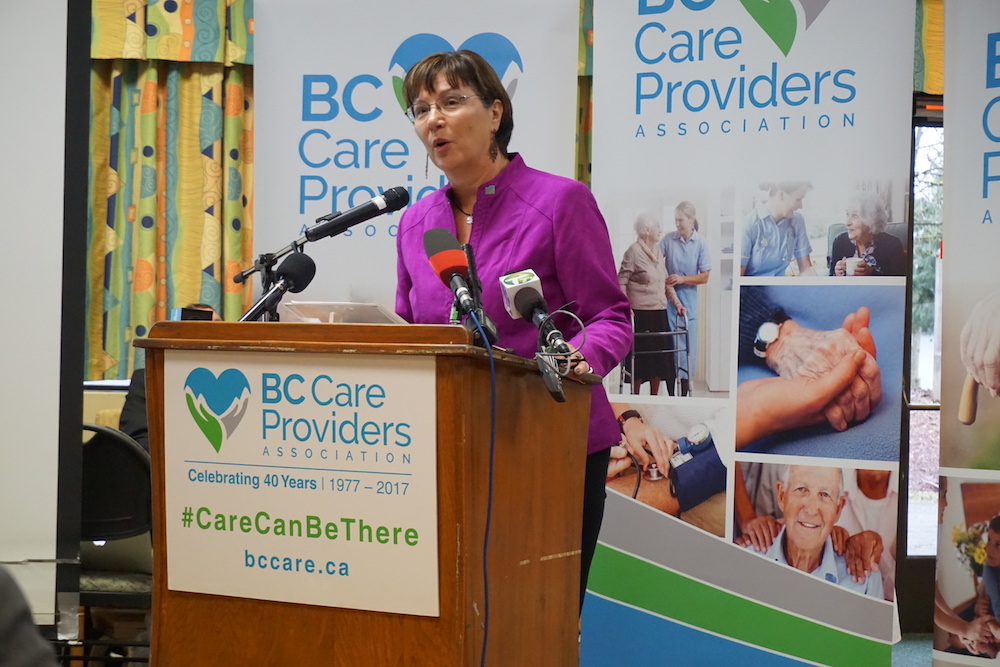In the wake of an Office of the Seniors Advocate publication showing that only 10 per cent of seniors in residential care are receiving the 3.36 hours per person per day of staffing care recommended by the provincial government (see “Guide shows staffing care for seniors has grown worse”, The Journal, February 9), the BC Care Providers Association (BCCPA) has launched a new campaign aimed at B.C. families who need more access to supportive seniors care.
The #CareCanBeThere campaign proposes more than $300 million in new annual investments in people, infrastructure, innovation, and quality of life that supports the province’s seniors. The BCCPA has tabled 30 recommendations to “enhance and innovate seniors’ care,” says BCCPA CEO Daniel Fontaine. The recommendations are the result of public consultations conducted around the province over the past year.
One of the highlights of “Investing in People” is investing up to $5 million per year for the next five years to recruit, train, and retain the necessary workers for a rapidly aging population. Speaking with The Journal, Fontaine said that they have looked into the possibility of increasing hours for current part-time workers already in the health-care system to full-time.
“That’s one way we are able to access the workers needed,” he says. “And that’s very critical, if we move to the 3.36 hours of care per day. We’ll have to train additional staff, which is critical for rural areas, as it’s difficult to attract people there.” He notes that an additional pressure is that people already in the profession are aging, and getting ready to retire.
“Our goal is to get the colleges filled up. There are successful strategies to get young people into health-care, but we have to educate people that these are well-paying entry jobs with benefits, and a proven way to advance.”
The BCCPA would also like to increase the minimum home-care visit to 30 minutes from the current 15 minutes, and allocate up to $20 million to re-purpose under-utilized and unused care beds in order to meet the B.C. government’s commitment to further expand end-of-life care by 2021.
“We’re hearing anecdotally about beds not being used, particularly in the private sector,” says Fontaine. “The public wants access to end-of-life care. Let’s repurpose funds to private care, repurpose these beds to end-of-life care, and free up acute-care beds in hospitals. We need to explore, and be innovative to provide seniors and families with more choices.”
Other highlights of the BCCPA’s plan include targeting up to $100 million towards new infrastructure funding to support the replacement and refurbishment of older care homes; piloting a new Care Credit program which would increase choice and access for seniors requiring home care and support services; and supporting the establishment of continuing care hubs, with a focus on rural B.C.
They would also like the Ministry of Health to set a target of no more than 5 per cent of acute-care beds in hospitals in 2021 be occupied by a senior waiting for care in the community. Currently about 13 per cent of hospital beds—at a cost of up to $1,800 per day—are filled by patients ready to be discharged into another level of care.
Fontaine acknowledges that this current state of affairs has been brewing for some time. “When you have too much time to plan, sometimes you don’t plan at all. We are heading into a provincial election, and this is the time to make your voice heard. Contact your MLA, get active, write letters to the editor, be heard. This is the time when politicians pay attention to what people say. We have a three-month window, and this is as important as hiring new teachers.
“We don’t have the luxury of another election cycle,” he adds. “We’re at a critical point, and we need to ensure someone presents a cohesive plan. I think we can do it, and we can make a difference.”
***
Story by Barbara Roden – Ashcroft Cache Creek Journal




